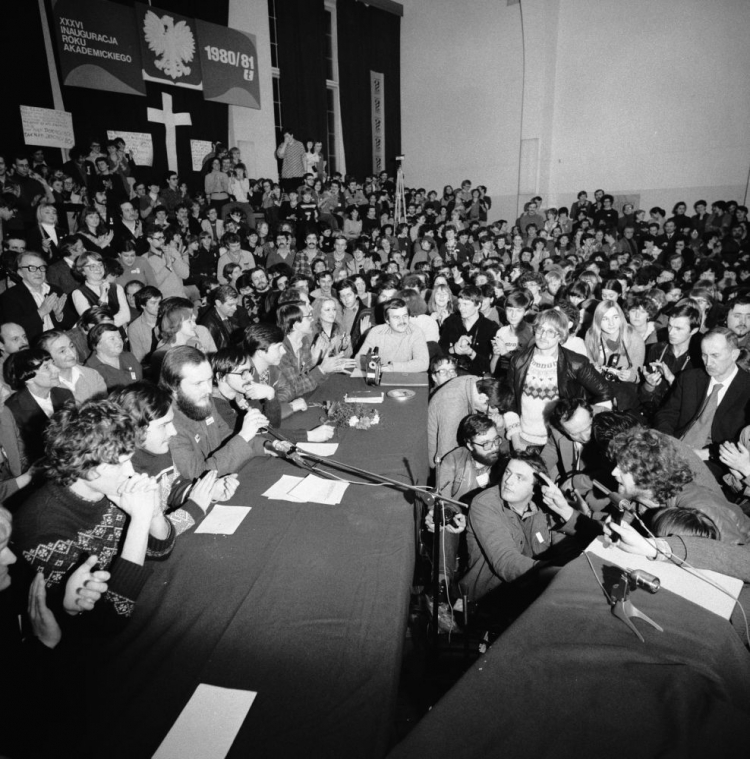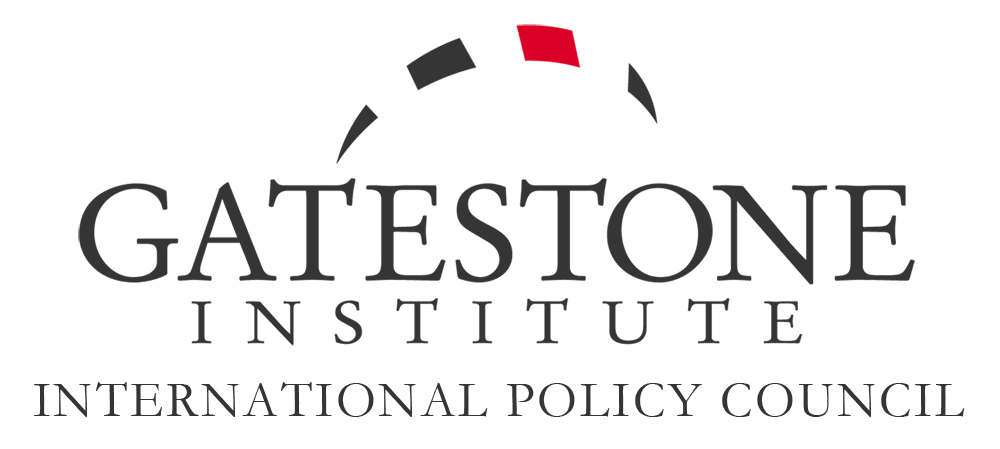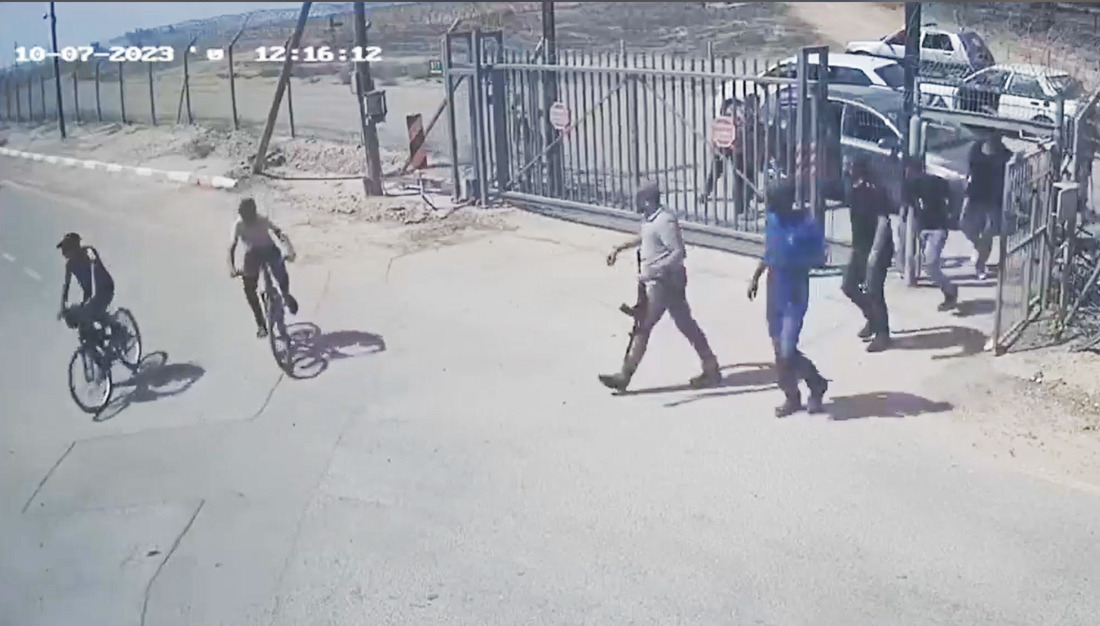 Komisja Porozumiewawcza studentów. Podpisanie porozumienia pomiędzy Komisją Międzyresortową pod przewodnictwem Ministra Nauki Szkolnictwa Wyższego i Techniki prof. Janusza Górskiego a Międzyuczelnianą Komisją Porozumiewawczą, wyłonioną spośród studentów łódzkich szkół wyższych: Akademii Medycznej, Państwowej Wyższej Szkoły Muzycznej, Politechniki i Uniwersytetu. Łódź, 18.02.1981. Fot. PAP/CAF/A. Zbraniecki
Komisja Porozumiewawcza studentów. Podpisanie porozumienia pomiędzy Komisją Międzyresortową pod przewodnictwem Ministra Nauki Szkolnictwa Wyższego i Techniki prof. Janusza Górskiego a Międzyuczelnianą Komisją Porozumiewawczą, wyłonioną spośród studentów łódzkich szkół wyższych: Akademii Medycznej, Państwowej Wyższej Szkoły Muzycznej, Politechniki i Uniwersytetu. Łódź, 18.02.1981. Fot. PAP/CAF/A. Zbraniecki
 43 lata temu zakończył się najdłuższy strajk studencki w Polsce
43 lata temu zakończył się najdłuższy strajk studencki w Polsce
Hubert Bekrycht
18 lutego 1981 r. zakończył się najdłuższy w historii strajk studencki w Polsce, po którym podpisano tzw. porozumienie łódzkie; spowodowało to m.in. rejestrację Niezależnego Zrzeszenia Studentów. Wprowadzono też m.in. autonomię wyższych uczelni i zniesiono obowiązek nauczania języka rosyjskiego.
Studenckie protesty z zimy 1981 r. rozpoczęte strajkiem w Łodzi zakończyły się sukcesem. “Porozumienie łódzkie dawało młodzieży akademickiej przekonanie o możliwości działania” – ocenił w 2021 r. w rozmowie z PAP historyk z Uniwersytetu Łódzkiego prof. Przemysław Waingertner (zmarł 31 stycznia 2024 r. – PAP). “Strajk uzmysłowił wszystkim, że nie tylko można przeciwstawiać się władzom i absurdom komunizmu, ale można też te absurdy likwidować” – podkreślił.
“Strajk studentów stanowił jedną z tych +cegieł+ budujących 40 lat temu świadomość, że pomimo komunistycznej dyktatury, można organizować się oddolnie” – wyjaśnił historyk. Przypomniał, że był to dopiero początek polskich przemian solidarnościowych. “Było też ważne poparcie protestu poza wyższymi uczelniami – i nie chodzi tylko o pomoc ekspertów – ale zwykłe solidarnościowe odruchy społeczeństwa” – dodał.
Studencki protest wsparli mieszkańcy Łodzi, którzy – mimo pustych półek w sklepach – przynosili okupującym uczelniane gmachy m.in. żywność i artykuły sanitarne. Publicyści związani z Solidarnością pisali, że Łódź była zimą 1981 r. studencką stolicą Polski a strajkujące łódzkie uczelnie archipelagiem wolności.
W efekcie trwających ponad trzy tygodnie rozmów z Międzyuczelnianą Komisją Porozumiewawczą NZS, 17 lutego 1981 r. zarejestrowano Niezależne Zrzeszenie Studentów. 18 lutego 1981 r. minister Górski parafował tzw. porozumienie łódzkie kończące największy strajk studencki w Polsce. Uczestniczyło w nim ok. 10 tys. osób, choć wiele źródeł historycznych podaje, że uczestników protestu było dużo więcej.
Ogłoszenie strajku okupacyjnego na Uniwersytecie Łódzkim było odpowiedzią na kolejną odmowę rejestracji NZS – niezależnej i samorządnej organizacji studenckiej. Strajk poprzedziła kilkunastodniowa akcja “Solidarne czekanie”. 21 stycznia do Łodzi przyjechała oficjalna delegacja ówczesnego Ministerstwa Szkolnictwa Wyższego i Techniki, której przewodniczył wiceminister Stanisław Czajka.
Negocjacje na Wydziale Filologicznym UŁ zostały jednak zerwane. Władze nie chciały przyznać studentom prawa do strajku i domagały się, aby organizacja, którą chcą zalegalizować, uznawała przewodnią rolę PZPR. O godz. 21 Wojciech Walczak i Wiesław Urbański – przewodniczący i wiceprzewodniczący NZS UŁ – wezwali studentów, by podjęli protest i nie opuszczali budynków uniwersyteckich. Rozpoczął się strajk, który trwał do 18 lutego i był – według Historii Niezależnego Zrzeszenia Studentów – najdłuższym strajkiem studenckim nie tylko w Polsce, ale i w Europie. Objął m.in Uniwersytet Łódzki, Akademię Medyczną, Politechnikę Łódzką, Państwową Wyższą Szkołę Muzyczną, Państwową Wyższą Szkołę Teatralną, Filmową i Telewizyjną, a pod koniec także Państwową Wyższą Szkołę Sztuk Plastycznych.
Studenci domagali się nie tylko rejestracji NZS, ale również autonomii uczelni, zniesienia obowiązku nauczania języka rosyjskiego, praktyk robotniczych i opresji związanych z zajęciami wojskowymi oraz swobodnego wyboru przedmiotów. Domagali się zniesienia cenzury, zaprzestania represji wobec opozycji, niezawisłości wymiaru sprawiedliwości i nowych podręczników historii.
Wybuch łódzkiego strajku spowodował protesty w innych ośrodki akademickich. 23 stycznia 1981 r. Ogólnopolski Komitet Założycielski NZS ogłosił w całym kraju solidarnościową akcję protestacyjną. 29 stycznia władze PRL podjęły negocjacje. Na czele rządowej Komisji Międzyresortowej – w której składzie byli w przedstawiciele ministerstw: Nauki Szkolnictwa Wyższego i Techniki, Kultury i Sztuki, Zdrowia i Opieki Społecznej, Sprawiedliwości oraz Sztabu Generalnego WP – zjawił się w Łodzi minister nauki, szkolnictwa wyższego i techniki prof. Janusz Górski.
W efekcie trwających ponad trzy tygodnie rozmów z Międzyuczelnianą Komisją Porozumiewawczą NZS, 17 lutego 1981 r. zarejestrowano Niezależne Zrzeszenie Studentów. 18 lutego 1981 r. minister Górski parafował tzw. porozumienie łódzkie kończące największy strajk studencki w Polsce. Uczestniczyło w nim ok. 10 tys. osób, choć wiele źródeł historycznych podaje, że uczestników protestu było dużo więcej.
“Strajk sprzed 43 lat wpłynął i nadal wpływa na moje życie i życie mojego pokolenia. Poczuliśmy, że komuna się łamie. Nigdy nie zapomnę tamtego poczucia, że robimy coś bardzo istotnego, to zupełnie przełomowe doświadczenie” – powiedział PAP ówczesny wiceprzewodniczący Komitetu Strajkowego Wydziału Filozoficzno-Historycznego UŁ, student III roku historii Zbigniew Natkański, obecnie prezes łódzkiego oddziału Stowarzyszenia Dziennikarzy Polskich.
“Osoby, które zaangażowały się w łódzki strajk studencki w 1981 r. dostały dobrą szkołę obywatelskiego myślenia. To procentuje do dziś. Większość osób, które brały udział w naszym strajku do tej pory jest aktywna społecznie i politycznie. Najważniejsze jest poczucie pewnej wspólnoty. Po tylu latach, mając naprawdę różne poglądy, rozmawiamy z sobą, kontaktujemy się często a nawet się przyjaźnimy” – podkreślił Natkański.
“O strajku dowiedziałem się, kiedy przyjechałem na wydział na tak zwaną giełdę pytań egzaminacyjnych, bo przecież zaczynała się sesja zimowa” – wspominał w 2021 r. dziennikarz Jacek Walczak, wówczas student II roku socjologii UŁ, były korespondent PAP w Łodzi. “Wróciłem do domu i rozmawiałem z żoną, bo mieliśmy wtedy małe dziecko. Wspólnie podjęliśmy decyzję, że tam pójdę. Pakując się, na szczęście, nie zapomniałem o amatorskiej kamerze marki +Łomo+ produkcji radzieckiej” – opowiadał. “Dzięki temu są filmy ze strajku” – podkreślił dodając, że te archiwalne taśmy były wielokrotnie wykorzystywane przez filmowców realizujących dokumenty o strajku.
Strajkujących studentów wspierali wykładowcy. “Studenci mieli do mnie zaufanie, ze względu na to, że doradzałem zarządowi regionu Solidarności” – wspominał zimą 2022 r. w rozmowie z PAP łódzki adwokat Rafał Kasprzyk (zmarł 6 sierpnia 2022 r. – PAP). 43 lata temu, jako wykładowca na wydziale prawa i jeden z założycieli Solidarności na UŁ był doradcą strajkujących.
“Już wcześniej działałem w opozycji, ale doświadczenie ze strajku, w którym brało udział wielu moich, niewiele młodszych ode mnie, studentów było szczególne. To ugruntowało moją opozycyjną postawę wobec reżimu komunistycznego” – podkreślił Kasprzyk.
“To wydaje się nieprawdopodobne, ale wtedy studenci nie umieli posługiwać się maszyną do pisania. Zatem byłem doradcą, ale też i sekretarzem strajku. Oczywiście to żart z tym sekretarzem, ale na maszynie pisałem” – opowiadał. “Ja to wszystko przepisywałem, redagowałem” – wyjaśnił. “Przy okazji +wrzucałem+ też swoje pomysły. Mojego autorstwa był na pewno postulat niezależności sądów i niezawisłości sędziowskiej, który się znalazł w tej grupie postulatów społeczno-politycznych” – wspominał dwa lata temu mec. Kasprzyk.
“Porozumienie łódzkie dawało młodzieży akademickiej przekonanie o możliwości działania” – ocenił w 2021 r. w rozmowie z PAP historyk z Uniwersytetu Łódzkiego prof. Przemysław Waingertner (zmarł 31 stycznia 2024 r. – PAP). “Strajk uzmysłowił wszystkim, że nie tylko można przeciwstawiać się władzom i absurdom komunizmu, ale można też te absurdy likwidować” – podkreślił.
Jego zdaniem, łódzki strajk zimowy z 1981 r. był prawdziwą lekcją demokracji dla młodych ludzi, którzy zbuntowali się przeciw komunistycznym rządom ekipy Wojciecha Jaruzelskiego.
Zarejestrowane 17 lutego 1981 r. Niezależne Zrzeszenie Studentów liczyło ok. 90 tys. członków, co stanowiło wtedy jedną trzecią wszystkich studentów w Polsce. Pierwszym przewodniczącym NZS był Jarosław Guzy. W stanie wojennym NZS, podobnie jak Solidarność, zostało zdelegalizowane, a wielu jego działaczy internowanych. W maju 1988 r. oraz późną wiosną 1989 r., tuż przed wyborami 4 czerwca, na uczelniach wybuchły strajki studentów domagających się ponownej legalizacji NZS, co nastąpiło we wrześniu 1989 r. (PAP)
Zawartość publikowanych artykułów i materiałów nie reprezentuje poglądów ani opinii Reunion’68,
ani też webmastera Blogu Reunion’68, chyba ze jest to wyraźnie zaznaczone.
Twoje uwagi, linki, własne artykuły lub wiadomości prześlij na adres:
webmaster@reunion68.com


 The participation of some Palestinian civilians in the October 7 massacre and the kidnapping of Israelis is extremely worrying: it illustrates that a large number of people in the Gaza Strip actually do support Hamas and its terrorism against Israel. Pictured: A Hamas terrorist and Palestinian civilian accomplices enter Kibbutz Be’eri to murder, rape and torture Jews, on October 7, 2023. (Image source: Kibbutz Be’eri security camera)
The participation of some Palestinian civilians in the October 7 massacre and the kidnapping of Israelis is extremely worrying: it illustrates that a large number of people in the Gaza Strip actually do support Hamas and its terrorism against Israel. Pictured: A Hamas terrorist and Palestinian civilian accomplices enter Kibbutz Be’eri to murder, rape and torture Jews, on October 7, 2023. (Image source: Kibbutz Be’eri security camera)
 .
.